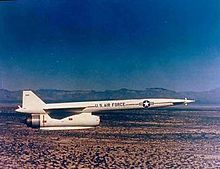| AGM-28 Hound Dog | |
|---|---|
 AGM-28 in flight (showing the nose-high attitude) | |
| Type | Cruise missile |
| Place of origin | United States |
| Service history | |
| In service | September 13, 1960 |
| Production history | |
| Manufacturer | North American Aviation |
| Unit cost | $690,073 |
| Produced | April 1959 |
| Specifications | |
| Mass | 10,147 pounds (4,603 kg) |
| Length | 42 feet 6 inches (12.95 m) |
| Height | 9 feet 4 inches (2.84 m) |
| Diameter | 28 inches (710 mm) |
| Wingspan | 12 feet 2 inches (3.71 m) |
| Warhead | 1,742 pounds (790 kg) W28 Class D nuclear warhead |
Detonation mechanism | Airburst or Contact |
| Engine | Pratt & Whitney J52-P-3 turbojet; 7,500 lbf (33 kN). |
Operational range | 785 miles (1,263 km) |
| Flight ceiling | 56,200 feet (17,100 m) |
| Flight altitude | 200 to 56,000 feet (61 to 17,069 m) |
| Maximum speed | Mach 2.1 |
Guidance system | Astro-inertial guidance |
Launch platform | B-52 Stratofortress |
The North American Aviation AGM-28 Hound Dog was a supersonic, turbojet-propelled, nuclear armed, air-launched cruise missile developed in 1959 for the United States Air Force. It was primarily designed to be capable of attacking Soviet ground-based air defense sites prior to a potential air attack by B-52 Stratofortress long range bombers during the Cold War. The Hound Dog was first given the designation B-77, then redesignated GAM-77, and finally AGM-28. It was conceived as a temporary standoff missile for the B-52, to be used until the GAM-87 Skybolt air-launched ballistic missile was available. Instead, the Skybolt was cancelled within a few years and the Hound Dog continued to be deployed for a total of 15 years until its replacement by newer missiles, including the AGM-69 SRAM and then the AGM-86 ALCM.